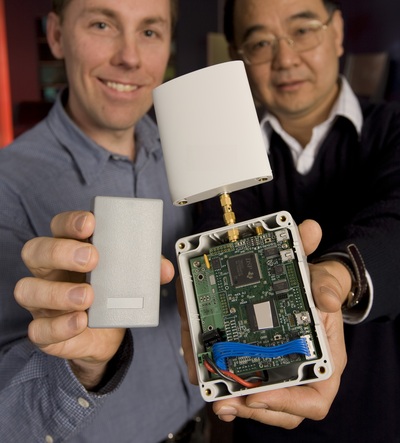WASPs let loose in underground mines
CSIRO has developed the Wireless Ad hoc System for Positioning (WASP) which can track people and objects to an accuracy of about half a metre where traditional technologies do not work and clear reception of radio signals is difficult. It has now been commercialised by mining communication company Minetec and incorporated into its Trax+Tags II suite for applications in underground mines.
Locating and tracking people and objects leads to increased safety and efficiency in many applications. Unfortunately, traditional technologies such as GPS and Wi-Fi tracking do not work well, or even at all, in many situations, such as underground, in open cut mines, in city CBDs, indoors or in disaster zones where existing infrastructure has been destroyed.

Through substantial research and development in wireless localisation technology, CSIRO has developed the Wireless Ad hoc System for Positioning (WASP) which uses low-cost, portable hardware to provide highly accurate tracking of people and objects where traditional technologies do not work and clear reception of radio signals is difficult.
WASP can track people and objects to an accuracy of about half a metre. It was commercialised by mining communication company Minetec and incorporated into its Trax+Tags II suite, which was launched at the Asia Pacific International Mining Exhibition in August.
“WASP is critical to modern underground mining and will significantly improve productivity, lower operational costs, and reduce health and safety issues for mining operations,” says Andy Sheppard, executive general manager of Minetec.
“The high-resolution situational awareness improves the accuracy of forecasted productivity, thus closes the gap between planned and actual targets.
“It is a revolutionary technology that offers a highly accurate, cost-effective tracking solution for underground mining and we are hoping to expand its use for aboveground in the near future.”
Wireless systems expert Dr Mark Hedley, who led the project, says WASP uses small mobile tags attached to vehicles or mine workers together with a series of reference nodes placed at known locations around the area being monitored.
“These nodes communicate wirelessly, calculating the arrival time of signals, allowing the system to accurately track the location and speed of objects as they move through an underground mine pit or tunnel,” he says.
“The technology can be used to locate workers in emergency situations and has the ability to act as a network that could send sensor data such as a worker’s heart rate, core temperature or gas or radiation levels in the surrounding environment.”
According to CSIRO, the biggest challenge in developing WASP was using inexpensive components to accurately track objects in difficult radio environments (where signals bounce off surfaces creating an echo-like effect known as multipath interference).
CSIRO developed algorithms that allow the time of arrival of signals, hence the position of the object being tracked, to be determined extremely accurately, even in the presence of severe multipath interference.
CSIRO
www.csiro.au
PPE supplier's disaster preparedness gets cyclone tested
The recent Severe Tropical Cyclone Alfred led a supplier of PPE to put into practice emergency...
Since the ban: Victoria gives an engineered stone update
Since the 1 July 2024 nationwide ban on the processing, manufacture and supply of engineered...
Study highlights the rapid rise of workplace silicosis
New research from Monash University has confirmed a disturbing increase in cases of silicosis...










